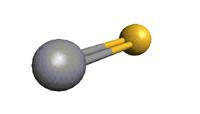|
Details of the global fit involving several isotopomers are
available in
(1) H. S. P. Müller, F. Schlöder, J. Stutzki, and G. Winnewisser,
2005, J. Mol. Struct. 742, 215.
The pure rotational lines were taken from
(2) M. Bogey, C. Demuynck, and J. L. Destombes,
1981, Chem. Phys. Lett., 81, 256; from
(3) M. Bogey, C. Demuynck, and J. L. Destombes,
1982, J. Mol. Spectrosc., 95, 35; from
(4) V. Ahrens and G. Winnewisser,
1999, Z. Naturforsch. 54a, 131;
(5) E. Kim and S. Yamamoto,
2003, J. Mol. Spectrosc., 219, 296;
and from
(6) C. A. Gottlieb, P. C. Myers, and P. Thaddeus
2003, Astrophys. J., 588, 655.
Infrared transitions v = 1 – 0 for several isotopomers
and v = 2 – 1 for the main isotopomer by
(7) J. B. Burkholder, E. R. Lovejoy, P. D. Hammer, and C. J. Howard 1987,
J. Mol. Spectrosc. 124, 450;
v = 1 – 0 to v = 9 – 8 of the
main isotopomer by
(8) R. S. Ram, P. F. Bernath, and S. P. Davies,
1995, J. Mol. Spectrosc. 173, 146;
and
v = 2 – 0 of the main isotopomer by
(9) R. J. Winkel, Jr., S. P. Davies, R. Pecyner, and J. W. Brault;
1984, Can. J. Phys. 62, 1414
were also used in the fit.
In general, lines deviating from their calculated position by
more than 2.5 times their uncertainties have been omitted from
the final fit.
Because of the global nature of the fit, predictions
could be made for this isotopomer even though no
transition frequencies have been recorded.
13C hyperfine splitting has NOT been
considered in the predictions and in the calculation of the
partition function !
The dipole moment was assumed to be the same as for the main
isotopomer, see e044501.cat.
All vibrational states used in the fit have been considered
for the calculation of the partition function. Contributions
of the individual vibrations are given in parentheses.
|
